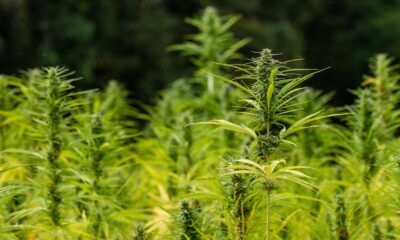Politics
Top Federal Drug Official Discusses Rise In Psychedelics Use And The Need To Study Marijuana From Dispensaries

Studies demonstrating the therapeutic benefits of psychedelics could be leading more people to experiment with substances like psilocybin, a top federal drug official said in a new interview with Marijuana Moment. And when it comes to cannabis research, she said scientists should be allowed to investigate products from state-legal dispensaries instead of using only government-grown plants.
National Institute on Drug Abuse (NIDA) Director Nora Volkow also spoke in the Thursday interview about the need to decriminalize drug possession and her surprise that teen marijuana use has not increased as more states enact legalization.
Volkow, who closely monitors emerging drug trends, particularly among youth, also discussed a new federal survey reveling that fewer college-aged adults are drinking alcohol and are instead opting for psychedelics and cannabis.
Monitoring the Future (MTF), a long-term epidemiological study, is meant to highlight patterns of behavior for the use of legal and illicit drugs, and its latest iteration found that past-year use of psychedelics like psilocybin and LSD among college students nearly doubled from 2019 to 2020, from five to nine percent.
At the same time, past 30-day alcohol use for that group decreased from 62 percent in 2019 to 56 percent last year. Volkow said the coronavirus pandemic likely helps explain that trend, as young people tend to drink alcohol more in social settings, and the health crisis ground much social interaction to a halt. But what’s to account for the abrupt change in behavior when it comes to psychedelics?
The survey itself doesn’t speculate about the reason for the shift, but Volkow says the surge in research and early clinical trials showing signs that these substances hold significant therapeutic value is a factor. She said people “start to discover the potential that these drugs have,” and they gravitate toward them.
Mainstream media outlets have started to take notice of the psychedelics research renaissance, feeding information to a larger audience that might be enticed by a substance that some studies show effectively addresses conditions like treatment-resistant depression, anxiety and post-traumatic stress disorder.
Volkow also said that she’d be “very surprised” if activist-led efforts to decriminalize or legalize certain psychedelics hasn’t also contributed to the new trend. And the timing makes sense. Denver became the first city in the U.S. to decriminalize psilocybin mushrooms in May 2019—and that set off a wave of reform movements in cities across the U.S. that continue to gain traction and attention.
In other words, there’s a newfound awareness within the general public that psychedelics are generally safe and potentially therapeutic and that laws criminalizing natural plants and fungi are loosening in various jurisdictions.
John Schulenberg, a University of Michigan research who is the principal investigator for MTF, told Marijuana Moment that he agrees with the director’s assessment.
“I think that’s what’s going on here. That is a societal change in terms of the [perception of] danger and possible benefits,” he said. “This is part of what’s happening society—that there are perceptions of the drug’s medicinal purposes, and science seems to be backing it up.”
Marijuana use among college students also increased in 2020, with 44 percent of that demographic reporting past-year cannabis consumption. Volkow again pointed to the COVID-19 crisis as a possible explanation, but it’s also the case that this has been a consistent trend for young adults in recent years.
But notably, that trend has not been observed among teens, with rates of past-year use for high school seniors remaining stable at 35 percent. It’s yet another datapoint that supports what reform advocates have long been arguing: just because more states are legalizing marijuana, that doesn’t mean more young people will start to use it. And in fact, having regulated markets that require proof of age can act as a deterrent.
In another recent interview, Volkow conceded that advocates were “right” that teen cannabis use wouldn’t spike after legalization was enacted. But while that’s encouraging, the official has been a consistent voice pushing for more and more research into marijuana, which is made all the more urgent amid the reform movement.
To that end, the director told Marijuana Moment that scientists have been unnecessarily limited in the source of cannabis they’re permitted to study—and it makes sense to enact a policy change that expands their access to products available in state-legal markets.
“Since dispensaries are selling products that are supposedly very specific for certain characteristics—there is not any one plant—without access to that variety and diversity of plant products, researchers cannot advance that question,” she said.
Volkow touched a wide range of drug policy issues in her conversation with Marijuana Moment. The interview below has been lightly edited for length and clarity.
Marijuana Moment: Looking at the 2020 MTF survey, do you have any thoughts on what might be driving the trend of increased use of psychedelics and marijuana among college students and the decrease in alcohol use at the same time?
Nora Volkow: Based on what we know, the first interpretation that I would make about why alcohol drinking has gone down pretty significantly—and particularly, alcohol drinking to intoxication and alcohol drinking in binging. And it’s among this population, what this is basically telling us, is that young people drink together, they go to bars, they go to a party. And to the extent that in COVID, we’ve been basically isolated, the opportunities for them to be physically in those spaces have gone down. And ergo, drinking has gone down. Whereas marijuana is a more solitary type of drug taking. People use it to relax and to stone themselves out. There are kids that go together, they actually go and smoke together, but it’s not the way that it is in alcohol, that social interaction.
MM: With respect to psychedelics specifically, do you feel like the activist-led push to reform laws governing substances like psilocybin over the past couple years has contributed to the increased use we’re seeing in this survey?
NV: I would be very surprised if he doesn’t influence it because that narrative actually has caught attention. These states are legalizing, so the media writes about it. And people start to discover the potential that these drugs have for therapeutics and the current trials that are ongoing. This takes on a momentum because the ideal world of having a drug that can cure things very dramatically. And there’s always that feel, like a fairy tale, that tells you something that is very appealing, and you immediately embrace it. This is the way that our brain works, we embrace theories that are within what we would like to see, much more than those that we would reject. So yes, I do suspect that it is the case.
I was speaking to my sister yesterday, and she lives in Mexico. And we were discussing the notion and she says, ‘Nora, I cannot go to museums, I cannot see my friends, my life has become very, very boring. And we need to live with this boring life.’ And it’s just occurred to me, that this is my older sister, and she’s complaining that her life has become very boring because of the isolation. How do you compensate for these these exciting activities? Psychedelic drugs is one of them. And so in that respect, it’s a very different drug from the others. It allows you to modify the perception of your environment. If you cannot go to a different environment, you can modify the way that that environment enters into your consciousness.
I think that those two components are facilitating the increase, because the increase was huge. It’s almost double in a one-year period. It’s a gigantic.
MM: The Drug Enforcement Administration (DEA) recently released updated quotas for the production of drugs for scientific use, and they greatly increased the allowed amounts for marijuana and psilocybin. Is that a sign that federal officials are seeing greater interest from researchers in investigating these substances? And if so, what are some of the areas you’d hope to see more research into?
NV: We’ve been working with the DEA and multiple agencies to try to actually address the challenges that have existed all along. Whether we approve or not, these drugs are being used. And if we don’t have access to research that informs us on these drugs, first of all, we cannot comment on what are their effects, if they have negative effects. And the fact that a lot of places are claiming that they have therapeutic potential, it becomes very, very difficult to do research with them. So we are working with the DEA to try to figure out ways that can facilitate doing research and expanding knowledge.
I think that this is actually a response to that. And I’m very grateful that this is happening because it will make it easier for investigators to understand the nature of the problem, but also importantly, to be able to provide the treatment if in case they are needed—if someone intoxicates and has an untoward reaction, that we understand how to treat it. But also the possibility—I mean, again, that’s why we do science—that some of these molecules, chemicals in these drugs, may have therapeutic benefits. If we don’t do research, we’ll never know.
MM: You’ve been a longtime critic of the monopoly on federally authorized marijuana production for studies. DEA also announced it will be approving additional manufacturers, but there are still some who feel strongly that scientists should have access to cannabis products available in state-legal markets. Where do you stand on that?
NV: I think it would be theoretically ideal to understand the actual products that people are consuming, as opposed to trying to understand it with a different compound—a different plant that will vary in terms of the contents of ingredients. And since the dispensaries are selling products that are supposedly very specific for certain characteristics, there is not any one plant so without access to that variety and diversity of plant products, researchers cannot advance that question. That’s something, again, that DEA has to enable, but from the the scientific perspective it would be valuable.
MM: You often discuss the societal consequences of criminalizing drugs, particularly on communities of color that are disproportionately targeted. What do you think would be a superior, alternative model?
NV: I would use what we have learned from other places that have tackled the issue with positive outcomes, and I’m very specifically thinking of Portugal.
I’m not specifically thinking in terms of Portugal as it relates to legalization because, overall, my concern with legalization is that it promotes the growth of a market of a problem which actually is optimized to make people addicted. And that leads to very negative consequences. I’m very concerned about the process of legalization unless there is a very good regulation that ensures that there’s not a profit that drives and jeopardizes the wellbeing of people. I’m very much against it. That’s one of the aspects that I see—I mean, has been so very negative. We pay a huge price with tobacco. How many people died that should have died because of that greed of the industry that’s selling these products?
But when I look at Portugal, what to me is very interesting is that they completely decriminalized—but what they’ve done in parallel is provide a treatment that is necessary. And that’s what we have not done in the United States. So when you say, why would I like to see? Absolutely, I’d like to see decriminalization of the individual that is taking drugs. There is no justification to put them in jail or prison. And in fact, it jeopardizes their outcome. But instead provide them with treatment.
What we do [now] is we throw people in jail, we remove their access to insurance, if they have any through Medicaid, and then they are thrown out. We have no support for reentry. It’s not surprising that leads to terrible outcomes.
MM: What steps can you, or NIDA, take to encourage lawmakers to enact a policy change to that end?
NV: We have a pretty large initiative, in part in partnership with the Arnold Foundation and the Justice Department, to do research that can help us develop strategies that provide alternatives.
MM: You said in a recent interview that advocates were ultimately “right” that state-level legalization wouldn’t increase youth use despite your initial fears. Is there anything else that’s surprised you about the impacts of the reform?
NV: Well, there are several issues that are concerning to me about what we’re seeing. First of all, we’re seeing that it has increased consumption across all ages other than teenagers. It has gone way up. And that includes pregnant women, so certainly that is very concerning. The other issue that is concerning to me, and we have keep an eye on it, is we’re seeing very strong associations between marijuana exposure and suicidal behaviors. And that is concerning. We’ve seen it in men and women, with or without depression. So that is an aspect that will have to be actually aware of.
It was a surprising finding [that past-year teen use has remained stable]. We’re also starting to see an increase in teenagers [who regularly use cannabis], not occasional use. It’s the regular use that is going up, which is the most dangerous, the daily use. And again, this may reflect, as you think about it, the notion that while legalization does not per se affect the likelihood that teenagers may be able to get marijuana because it’s widely available. The legalization, though, may have facilitated the ability to get marijuana right away. That is why we may be seeing this distinction.
We need to actually see what happens with those indicators because, right now amid the COVID pandemic, it’s difficult to judge because teenagers are at home and what we see is parents may have, particularly those that stay at home, have greater supervision of those kids. So, taking drugs is going down. But on the other hand, kids whose parents are out there working, no supervision, this may lead to higher drug consumption. And that’s sort of where we’re seeing. But as it relates to overall regular marijuana, when we go back to whatever normal is, we will get a better idea if these trends keep going up or not.
Mayors Across The U.S. Push Biden And Congress To Legalize Marijuana With A Focus On Racial Equity
Image element courtesy of Kristie Gianopulos.















